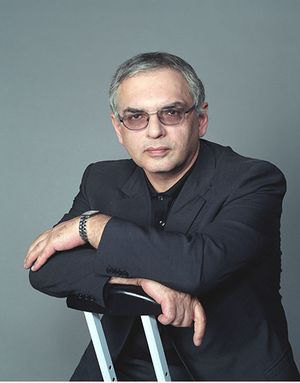The tragic story of Anna Karenina has been adapted for the silver screen many times through the years (1915, 1918, 1935, 1948, 1967, 1985, 1997 and last in 2012). Each time, however, the director of the film sets his own imprint in a most effective way. Prominent Russian filmmaker Karen Shakhnazarov continues this saga with his latest outing— Anna Karenina: Vronsky’s Story. Film director, screenwriter, producer and novelist, 65-year old Shakhnazarov is presently the general director and chairman of the board of directors of Mosfilm cinema concern.
Under his leadership, Mosfilm, Russia’s largest film studio not only survived a difficult period during the 1990s, but grew to become the largest single filmmaking concern in Europe. Operating at a global level, the studio now produces the greater share of Russian cinema, videos and television shows. Over the years, Shakhnazarov’s films have been screened at several of the most prestigious international film festivals where they have garnered more than 20 awards in various categories. His films Ward No. 6 and White Tiger were selected as the Russian entries for Best Foreign Language Film at the Oscars.
 Director Karen Shakhnazarov
Director Karen Shakhnazarov
There is no single truth in love. Which one should take precedence—passion or duty? How do we choose? And who gets to judge? These are eternal questions, remorselessly thrust upon us by life. Anna Karenina made her choice, leaving her son Sergei to grow up struggling to understand why his mother took such a tragic and terrible path.
Anna Karenina: Vronsky’s Story features Elizaveta Boyarskaya as Anna Karenina, Maksim Matveyev as Vronsky, Vitaly Kishchenko as Karenin and Kirill Grebenshchikov as Sergey Karenin. As the title suggests, Shakhnazarov's adaptation looks at the classic story from a male perspective, with Count Vronsky at the centre of the plot. Vronsky is haunted by the memory of the woman for whose death he blames himself 30 years later.
In 1904, in the aftermath of the Russian–Japanese war, Sergei Karenin and Alexei Vronsky find themselves thrown together in a remote Manchurian village, where fate offers them a chance to return to the events long past and, finally, to find the answers both have long been seeking.
Excerpts from interview with director Karen Shakhnazarov:
What prompted you to attempt an epic romantic saga like Anna Karenina?
I have wanted to make a film about love for a long time, and what could be more interesting than filming Anna Karenina? The way I see it, nothing better has ever been written, or will ever be written, about relationships between men and women. This is why I was extremely careful to follow the original text in the part of the film which deals with the relationship between Anna, Vronsky and Karenin. Both the plot and the dialogue are unchanged.
How is the treatment of Anna Karenina different from the earlier 2012 version?
The film of 2012 is a theatrical stylisation. Stylisation in everything: in costumes, in sets, in genre conception. I don’t like it, though tastes differ. It is impossible to reveal the essence of such a complicated and big novel as Anna Karenina in a couple of hours. We took the line of the relationship between Anna Karenina, Vronsky and Karenin to concentrate on highlighting the most important, to my mind, relationships for people—relationships between a man and a woman.
What are the special nuances that you have incorporated in your production to cater to current audiences?
While preparing for shooting we tried to re-create the true atmosphere of the period of the story, the end of the XIX century and the beginning of the XX. A vast number of documentary materials on the period were studied, all military uniforms and civil costumes and film sets were made according to those materials. At the end of the XIX century, electric lights were rare even in cities. So, to make the lighting authentic, all evening and night scenes were shot by candlelight only, without electric light. Candlelight creates a completely different world: a different sense of space, different smells, and different colours. The yellow, flickering light even changes facial expressions.






